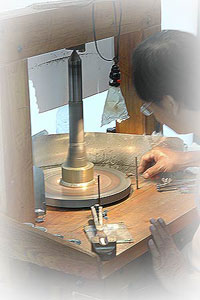|
|
Your Details
|
|
Your Details
|
Reviewed By Andreas Zabczyk
Native Cut Gemstones Traditional Gem Cutting
The term "native cut" is a term that has unfortunately been widely adopted in the gemstone trade. It is typically used to refer to badly cut gems that display faults such as windowing, poor polish and imperfect facet meets. Certainly we need a term to refer to poorly cut gems, but the term "native cut" is probably not the best term. It implies that the stones are cut by primitive people ("natives") in developing countries who lack the skill and technology to cut gemstones properly. Some people defend the use of the term "native cut" by explaining that it doesn't have this negative connotation at all - it simply means that the stones were cut in the country where they were mined, whether it be Burma, Sri Lanka, India, Thailand or Brazil. This definition seems lacking since many "native cut" African gems that originate in Tanzania, Kenya and Mozambique are actually cut in Thailand. It also seems that no one refers to Montana sapphires cut in the United States as "native cut". "Native cuts" are distinguished from "custom cuts", which is a term that refers to gems cut to particular specifications. Gemstones can be cut using traditional methods or modern faceting machines. Faceting is a process of grinding flat planes on a piece of gem material by pressing the gem against a rotating disk (called a lap) that is impregnated with an abrasive such as powdered diamond. Modern faceting machines feature sophisticated metallic control arms that allow precise control of the cutting angle and rotation of the stone. There is no question that it takes more skill to cut gems using less sophisticated control arms, such as the traditional jamb peg device, to position the gem on the lap. Modern faceting machines allow the operator to "dial-in" the desired settings, and therefore allow better control of the angles and proportions of the cut. Traditional cutting requires a practiced eye and a good feel for the material being worked. The symmetry of machine-cut gems is usually better since it doesn't depend on the eye of the cutter alone. Half automatic gem cutting machines allow for quicker cutting and help to achieve matching shapes and sizes for calibrated gems. However, such standard machine-cut gems are not as exact as "precision cut" gems. As the name "precision cut" suggests, it is very precise in all respects! This means that angles, facet sizes, proportions and polishing is at the highest level of the gem cutting business. The precision cut is the most time-consuming cutting process of all. Skilled practitioners of traditional gem-cutting consistently produce gems of exceptional quality. Nevertheless, variations in style and economic factors contribute to the distinctions between "native cut" and "custom cut" gemstones.  Modern Faceting Machine
Gem cutters in Thailand, Sri Lanka and India have traditionally cut colored stones to maximize their color. Dark-colored gems are often cut with a slight window to lighten the color, while less saturated colors are cut with a larger pavilion to deepen the color. Custom-cut gems follow the precision cutting style of the diamond industry, that aims to achieve optimum angles to maximize brilliance. In many developing countries it used to be a common practice to maximize weight retention when cutting a gem. This meant that rough material would be cut in such a way that the carat weight of the final product would be as high as possible. This economic strategy undoubtedly led to some of the cutting defects associated with so-called "native cuts". It wasn't actually bad cutting that led to the less than desirable results; the stone was cut that way by intention. These days many Asian cutters know that well-cut stones will attract a better price, so the economic strategy has changed. However, they still tend to cut to maximize color. The slightly bulbous pavilion you see on some "native-cut" stones means that many of these stones have longer light paths, resulting in gems with richer colors than many "precision cut" gems that remove all excess material from the finished stone. |
